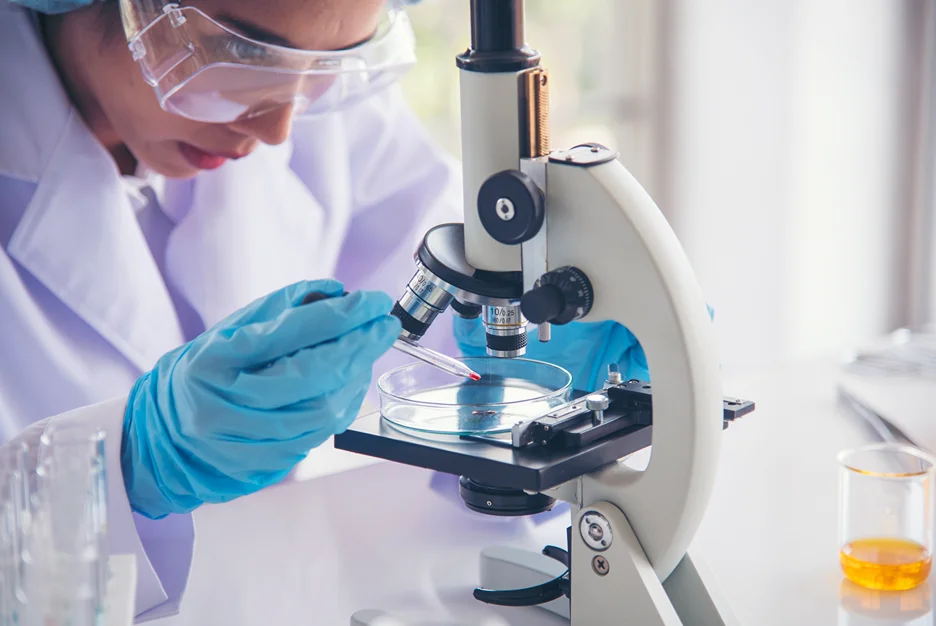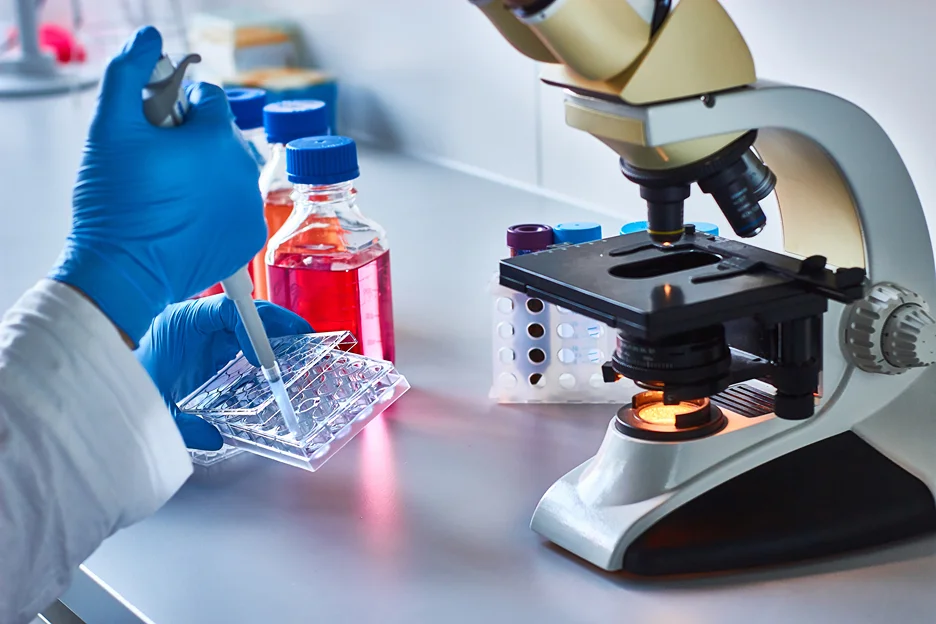Extracellular vesicles (EVs) and exosomes are tiny yet powerful subcellular structures that have recently come into focus for their critical roles in cellular communication and disease.
But what exactly are EVs and exosomes, and how are they similar or different?
In this article, we’ll take a deep dive into these biological particles, examining everything from how they are formed and released by cells to their functions and potential therapeutic uses.
What Are Extracellular Vesicles?

Extracellular vesicles are lipid bilayer-enclosed particles naturally released from almost all cell types in the body. Ranging from 20-30 nanometers to over 10 microns in diameter, most EVs are less than 200 nm in size.
Despite their diminutive dimensions, EVs pack a punch – they carry proteins, genetic material, lipids, and metabolites from their cells of origin and can transport these molecular components between cells.
Structurally, EVs have a few key features:
- Lipid bilayer membrane enclosure
- Cytoplasmic proteins and nucleic acids
- Diverse lipid composition
- Range of sizes, predominantly <200 nm
EVs are generated through several cellular processes, including plasma membrane budding and fusion of multivesicular bodies with the cell surface. Their release appears to be evolutionarily conserved across archaea, bacteria, and eukaryotes.
In the body, EVs participate in critical physiological activities:
- Transporting biomolecules between cells
- Mediating cell-to-cell communication
- Transferring surface receptors between cells
- Delivering proteins and genetic material
- Stimulating immune responses
With such a diverse functional repertoire, it’s not surprising that EVs have been implicated in various diseases. Analyzing EVs in biofluids is an emerging approach for minimally invasive diagnostics and monitoring of cancer, neurodegenerative diseases, diabetes, and more.
Exosomes – A Special Type of Extracellular Vesicle
Exosomes represent a specific population of EVs originating from the endosomal pathway in cells.
During endocytosis, portions of the plasma membrane are internalized into the cell’s interior within endosomes. Intraluminal vesicles (ILVs) form by invagination and scission from the endosomal membrane.
These ILVs accumulate within large multivesicular bodies (MVBs). When an MVB fuses with the plasma membrane, the ILVs within it are released as exosomes. Compared to other EVs, exosomes are smaller and more homogeneous in size, typically 30 to 150 nm.
They also exhibit a characteristic cup-shaped or saucer-like morphology under electron microscopy, unlike the more irregular structure of other EVs. Their lipid composition is distinct with enrichment of cholesterol, sphingomyelin, and ceramide.
Biological Functions and Implications
Exosomes contain cytosolic proteins from their cell of origin as well as genetic cargo like mRNA, microRNA, and even DNA. This material reflects the physiological state of the parent cell.
For instance, tumor-derived exosomes contain oncogenic proteins and RNAs that mirror molecular changes within cancer cells.
Once secreted, exosomes transmit information to recipient cells by transferring biomolecules and stimulating cell signaling pathways.
They have specialized roles in the immune system and neuronal communication. Exosome research is revealing valuable insights into normal physiology as well as disease:
- Immune activation: Exosomes from antigen-presenting cells activate T cell responses.
- Cancer progression: Tumor exosomes promote angiogenesis, metastasis, and drug resistance.
- Neurodegeneration: In models of Alzheimer’s, exosomes spread pathogenic proteins between cells.
- Biomarkers: Exosomal proteins and RNAs can provide diagnostic and prognostic information in various cancers.
Key Differences Between Extracellular Vesicles and Exosomes
While extracellular vesicles and exosomes overlap in their basic properties, there are a few key differences:
| Characteristic | Extracellular Vesicles (EVs) | Exosomes |
| Size | Generally larger, varying from 20-30 nm to over 10 µm. | Smaller, typically around 30 to 150 nm in diameter. |
| Origin | Released by almost all types of cells, not restricted to endosomal origin. | Formed in the endosomal compartment through the inward budding of MVBs. Released when MVB fuses with the cell surface. |
| Composition | More variable composition. | Enriched in certain proteins like tetraspanins and have a distinct lipid profile. |
| Isolation | Specialized techniques needed for separation based on size, density, or protein markers. | Specialized techniques may indeed be needed to separate from EVs. |
| Functions | Broad range of functions: transporting biomolecules, mediating communication, transferring receptors, delivering proteins and genetic material, stimulating immune responses. | Unique communication roles, especially in the immune system. |
So in summary, exosomes represent a specific population of small EVs formed through the endolysosomal pathway. Their size, origin, composition, and functions distinguish them from other heterogeneous EVs.
Biogenesis and Release of Exosomes and EVs
Exosomes and other EVs follow distinct biogenic pathways:
Exosome Biogenesis
Exosome production starts with endocytosis – plasma membrane internalization into early endosomes. A subset of these endosomes matures into late endosomes or multivesicular bodies (MVBs) by budding small ILVs into their interior. MVBs containing ILVs then traffic to and fuse with the plasma membrane, releasing the ILVs as exosomes.
Molecular players in this process include the ESCRT complex, required for ILV formation, as well as Rab GTPases and SNARE proteins that mediate MVB trafficking and fusion. Exosome release increases under cellular activation or stress.
EV Biogenesis
For plasma membrane-derived EVs, outward budding results directly in EV release. This occurs continuously at low levels but increases upon cell activation by calcium influx and cytoskeletal reorganization. Apoptotic bodies represent another type of EV, released from dying cells as blebs of membrane that can be large and heterogeneous.
Additional Considerations
Recent studies have shown the complexity of EV formation and the various factors affecting it.
For instance, besides the ESCRT complex, there are other pathways involved in making exosomes. Also, the selection of cargo within EVs, like proteins, lipids, and nucleic acids, is very specific and impacts the exosomes’ roles.
EVs play increasingly recognized roles in health and disease, being involved in immune system regulation, viral infections, and even body clock control. Their potential in medicine is also under investigation, particularly in drug delivery and as markers for diagnosing and tracking diseases.
Roles of Exosomes and EVs in Cellular Communication and Disease

By transferring informational molecules between cells, exosomes and EVs enable short- and long-range intercellular communication. However, abnormalities in these processes contribute to pathologies like cancer, diabetes, and neurodegeneration.
Facilitating Cell-to-Cell Signaling
Exosomes and EVs transmit proteins, lipids, and genetic cargo that alter molecular pathways and behaviors of recipient cells. Key communication roles include:
- Surface receptors – Transferring functional surface proteins like chemokine receptors between cells.
- Genetic exchange – mRNAs and regulatory non-coding RNAs induce epigenetic changes in recipient cells.
- Antigen presentation – Immune cell exosomes display antigenic peptides to activate T cell responses.
- Proangiogenic signaling – Cancer cell EVs stimulate endothelial cell migration and tube formation to support tumor vascularization.
Such intercellular exchange allows coordination of local and systemic responses like immunity, tissue growth, metabolism, and more.
Involvement in Disease
Aberrant EV and exosome release contributes to various pathologies:
- Cancer – Tumor EVs promote angiogenesis, prime metastatic sites, and confer drug resistance by transferring oncoproteins and bioactive RNA molecules.
- Neurodegeneration – Exosomes mediate propagation of misfolded proteins like amyloid beta and alpha-synuclein in Alzheimer’s and Parkinson’s diseases.
- Cardiovascular disease – Platelet and endothelial EVs trigger thrombosis and inflammation underlying heart attacks and strokes.
- Diabetes – Exosomes from insulin-resistant tissues exacerbate metabolic dysfunction in diabetes.
As Dr. Hardik Soni, cosmetic physician and founder of Ethos Aesthetics & Wellness, explains, “Research into EVs and exosomes is uncovering new pathogenic mechanisms and identifying signature molecules with strong potential as minimally invasive diagnostic biomarkers.”
Isolating and Characterizing Exosomes
Studying exosomes requires separating them from other EVs and contaminants in complex biological fluids or tissue samples. Common exosome isolation approaches include:
- Ultracentrifugation – High speed centrifugal force pellets exosomes away from soluble proteins.
- Size exclusion chromatography – Fractionation by size through a porous matrix.
- Immunoaffinity capture – Antibodies target exosomal surface proteins like tetraspanins.
- Microfluidic devices – Miniaturized labs-on-a-chip exploit exosome properties like size and surface charge.
Analysis of isolated exosomes provides information on their individual and collective properties:
- Particle counts – Nanoparticle tracking analysis quantifies exosome numbers.
- Size distribution – Techniques like tunable resistive pulse sensing assess diameter.
- Morphology – Electron microscopy reveals the classic saucer/cup-shaped exosome structure.
- Surface markers – Flow cytometry detects exosome-specific proteins like CD63.
- Cargo components – RNA sequencing and proteomics identify exosomal mRNAs, miRNAs, and proteins.
Such analyses shed light on exosome quantities, quality, and molecular contents in physiological and disease states.
Harnessing the Therapeutic Potential of EVs and Exosomes
The natural bioactive properties of EVs and exosomes are spurring development of revolutionary medical applications, including:
Regenerative Medicine
Mesenchymal stem cell EVs and exosomes exhibit potent tissue repair and anti-inflammatory effects in preclinical studies of wound healing, ischemic injury, and autoimmunity. “At Ethos, we are actively investigating the use of exosomes as novel, cell-free therapies for aesthetic procedures and regenerative skin rejuvenation,” shares Dr. Soni.
Drug Delivery
The encapsulating nature of EVs enables delivery of chemotherapeutic drugs, antibodies, siRNAs, and CRISPR gene editing machinery specifically to tumors while evading immune clearance.
Vaccines
Dendritic cell or cancer cell EVs displaying antigens prime potent antiviral and antitumor immune responses, representing a novel mode of therapeutic vaccination.
However, clinical translation faces challenges of scalable manufacturing, quality control, and assessing pharmacodynamics. “Clinical trials are needed to establish safety and dosing before advancing EV/Exosome therapies to broader patient populations,” advises Dr. Soni.
Regulating EV-Based Treatments
As research intensifies, regulatory agencies are developing frameworks for responsible translation of EV therapies:
- The FDA now legally classifies exosomes as drugs, requiring investigational new drug (IND) approval for clinical trials.
- Strict safety and efficacy standards for approval account for therapy purity, potency, target toxicity, etc.
- Guidelines urge cautious use of the term “stem cell” to avoid misrepresenting EV/exosome products.
Ethical considerations around commercialization must also be addressed. “Clinicians like myself have a responsibility to ensure patients understand that, while promising, EV therapies remain investigational with unproven benefits,” stresses Dr. Soni. “We cannot allow premature marketing to create misunderstanding.”
An Exciting Frontier in Biomedicine

Recent discoveries in extracellular vesicles and exosomes represent a paradigm shift in our understanding of intercellular communication. Ongoing advances in isolating and harnessing EVs continue to unravel their profound importance in physiology.
“Exosomes are opening up entirely new possibilities for diagnosing and treating complex diseases like cancer, autoimmunity, and neurodegeneration,” says Dr. Soni. “Moreover, their regenerative properties are paving the way for advances in rejuvenation and beauty treatments. This is truly just the beginning—EVs are an exciting new frontier with immense clinical potential.”
While challenges remain, the power of EVs and exosomes to improve human health will undoubtedly be realized through rigorous scientific research and responsible medical application.






